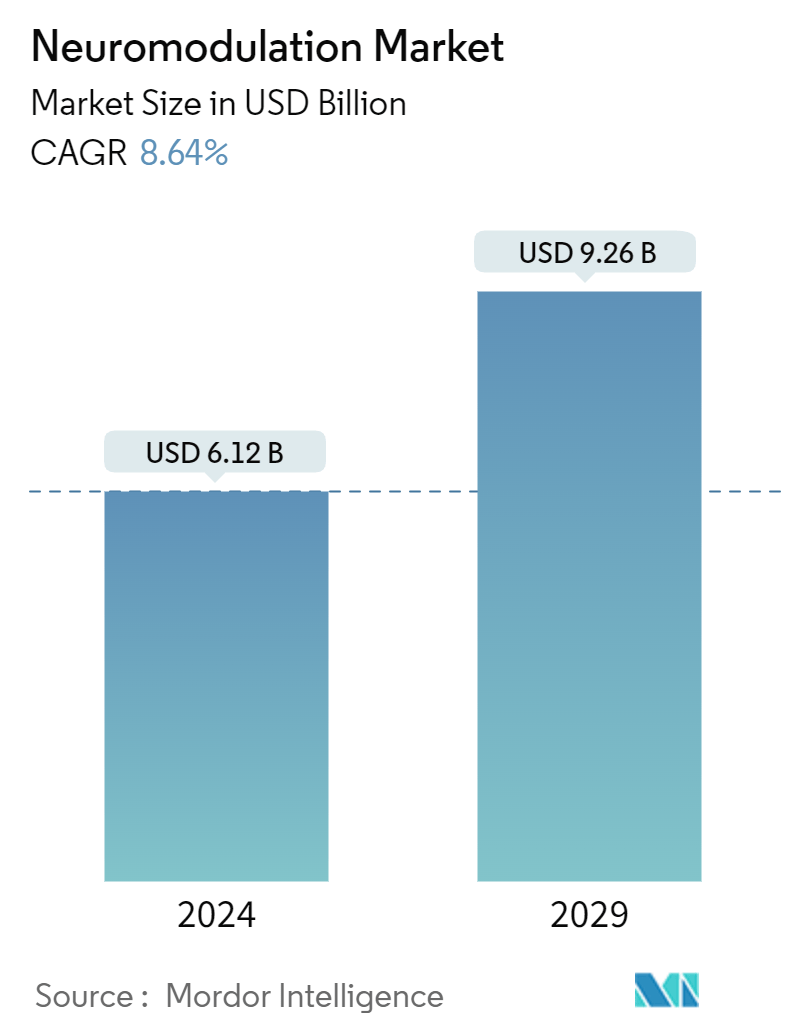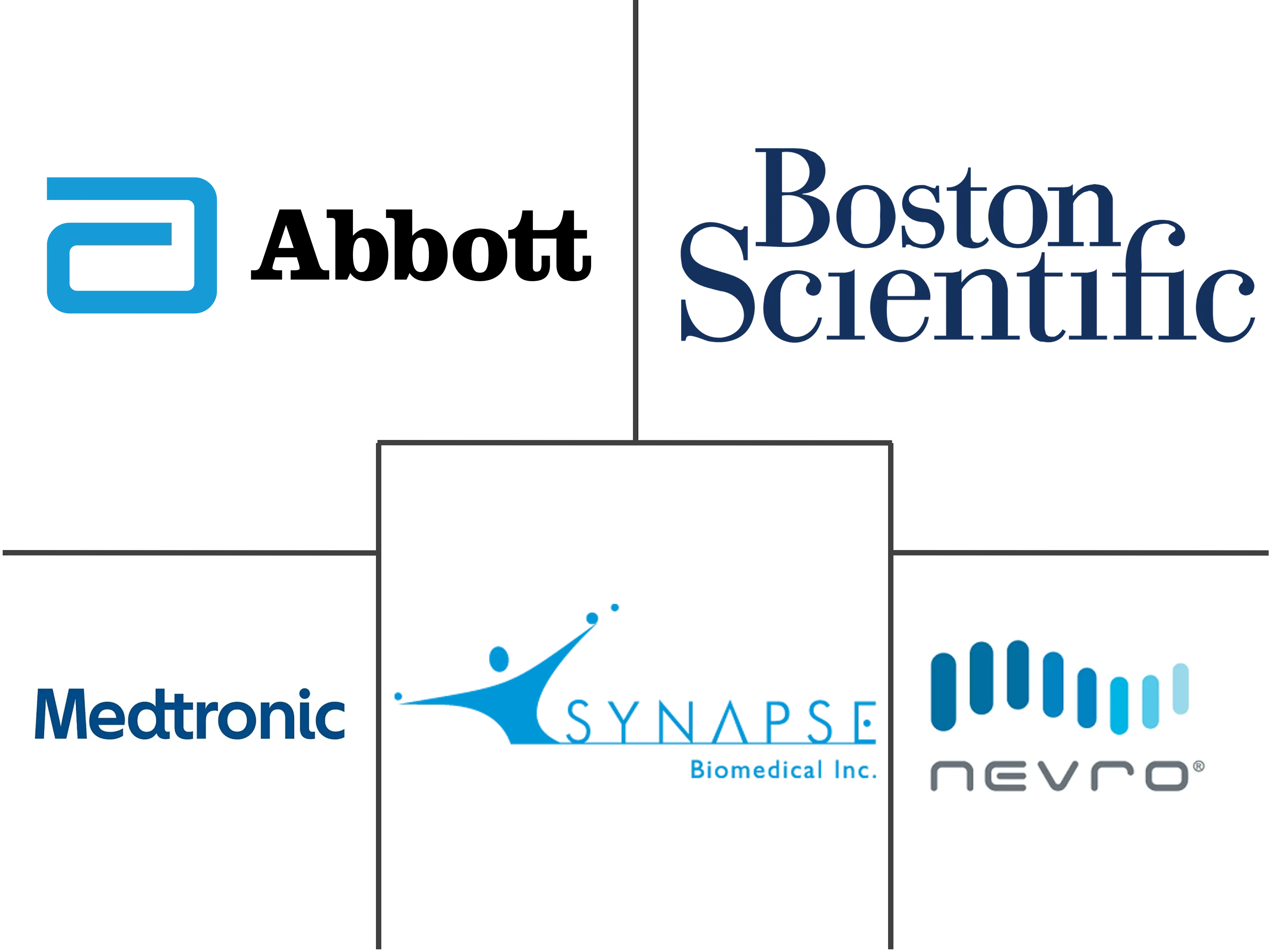Market Size of Neuromodulation Industry

| Study Period | 2019 - 2029 |
| Market Size (2024) | USD 6.12 Billion |
| Market Size (2029) | USD 9.26 Billion |
| CAGR (2024 - 2029) | 8.64 % |
| Fastest Growing Market | Asia Pacific |
| Largest Market | North America |
| Market Concentration | Medium |
Major Players
*Disclaimer: Major Players sorted in no particular order |
Neuromodulation Market Analysis
The Neuromodulation Market size is estimated at USD 6.12 billion in 2024, and is expected to reach USD 9.26 billion by 2029, growing at a CAGR of 8.64% during the forecast period (2024-2029).
- The onset of the COVID-19 pandemic significantly impacted the studied market during the initial phases of 2020. Elective surgeries and other treatments were postponed in accordance with government restrictions, including neuromodulation procedures. As neuromodulation requires surgical interventions for the treatment of target patients, postponing neuromodulation procedures created obstruction in the demand and supply of the devices used during the procedures. This hampered the adoption and sales of the systems and devices and adversely impacted the market studied.
- However, in 2021, the need for neuromodulation increased as a result of numerous studies that suggested COVID-19 patients have benefited from using neuromodulation devices. For instance, as per a research study published in the European Pharmaceutical Review journal in July 2021, neuromodulation was used to treat a group of patients with chronic COVID-19 symptoms, and all of them reported significant improvements in their symptoms within 14 days of beginning the treatment.
- Hence, such instances fueled the adoption of neuromodulation procedures during the later phases of the pandemic. Meanwhile, with the onset of various strains of the SARS-CoV-2 virus and associated post-COVID symptoms, the application of neuromodulation technologies is increasing and is anticipated to contribute to the growth of the studied market during the forecast period.
- Factors such as the rising prevalence of neurological disorders, the increase in the aging population, and new indications and expanded target applications are primarily anticipated to drive the overall market growth during the analysis period.
- The number of populations suffering from dementia and other neurological disorders is rising globally, and it is expected to create numerous opportunities for the adoption and development of neuromodulation technologies and procedures. According to a research study published in the Neuroscience Insights journal in August 2022, when the epidemiological data from several countries across the globe were analyzed, the prevalence and increasing global burden of dementia, Alzheimer's Disease, Parkinson's disease, multiple sclerosis, and motor neuron diseases was reported to be high in 195 countries worldwide, during the study period. Hence, this burden of neurological diseases is anticipated to create opportunities for neuromodulation devices, further driving the overall growth of the market.
- Moreover, the burden of neurological diseases has led many market players to focus on the development of neuromodulation products. This is creating a competitive environment in the market studied. For instance, in January 2021, Functional Neuromodulation received the Breakthrough Device designation from the Centre for Devices and Radiological Health, the United States, for the Vercise Deep Brain Stimulation (DBS) Systems. Functional Neuromodulation has developed a deep brain stimulator BDS-f DBS system designed to treat Alzheimer's. Patients with mild probable Alzheimer's disease who are 65 years of age or older are eligible for therapy. With this approach, the established effectiveness and expanding adoption of this technology are expected.
- In addition, in July 2022, Abbott Laboratories received FDA Breakthrough Device Designation recognition, which allows them to investigate the use of deep brain stimulation (DBS) in managing severe treatment-resistant depression.
- Therefore, the availability of various products is expected to lead to a surge in market demand during the forecast period. However, inconsistent reimbursement policies and a lack of trained professionals are expected to hinder the market growth during the forecast period.
Neuromodulation Industry Segmentation
Neuromodulation is a technology that affects nerves directly. It is the modification of nerve activity through the direct delivery of electrical or pharmacological substances to a specified location.
The neuromodulation market is segmented by technology (internal neuromodulation (spinal cord stimulation, deep brain stimulation, vagus nerve stimulation, sacral nerve stimulation, gastric electrical stimulation) and external neuromodulation (transcutaneous electrical nerve stimulation, transcranial magnetic stimulation, and other external neuromodulations)), application (Parkinson's disease, epilepsy, depression, dystonia, pain management, and other applications), and geography (North America, Europe, Asia-Pacific, Middle East and Africa, and South America). The market report also covers the estimated market sizes and trends for 17 different countries across major regions globally.
The report offers the value (in USD) for the above segments.
| By Technology | |||||||
| |||||||
|
| By Application | |
| Parkinson's Disease | |
| Epilepsy | |
| Depression | |
| Dystonia | |
| Pain Management | |
| Other Applications |
| By Geography | ||||||||
| ||||||||
| ||||||||
| ||||||||
| ||||||||
|
Neuromodulation Market Size Summary
The neuromodulation market is poised for significant growth, driven by the increasing prevalence of neurological disorders and the aging population. The market experienced initial setbacks due to the COVID-19 pandemic, which led to the postponement of elective surgeries and neuromodulation procedures. However, the later phases of the pandemic saw a resurgence in demand as studies highlighted the benefits of neuromodulation for COVID-19 patients with chronic symptoms. This shift, along with the rising incidence of conditions such as dementia, Alzheimer's, and Parkinson's disease, is expected to create numerous opportunities for the adoption and development of neuromodulation technologies. The market is characterized by a competitive landscape, with major players focusing on innovative product development to address the growing burden of neurological diseases.
North America is a key region in the neuromodulation market, with the United States leading due to its established pharmaceutical and biopharmaceutical industries and significant investments in advanced technologies. The increasing incidence of Parkinson's disease and other neurological conditions has spurred research and development in neuromodulation devices, opening new avenues for market growth. Regulatory approvals from the FDA have further intensified competition, encouraging the innovation of advanced products. The market's competitive nature is underscored by the presence of major players such as Medtronic PLC, Boston Scientific Corporation, and Abbott Laboratories, who are actively investing in new technologies to enhance their product offerings and capture a larger market share.
Neuromodulation Market Size - Table of Contents
-
1. MARKET DYNAMICS
-
1.1 Market Overview
-
1.2 Market Drivers
-
1.2.1 Rising Prevalence of Neurological Disorders
-
1.2.2 Increase in the Aging Population
-
1.2.3 New Indications and Expanded Target Applications
-
-
1.3 Market Restraints
-
1.3.1 Inconsistent Reimbursement Policies
-
1.3.2 Lack of Trained Professionals
-
-
1.4 Porter's Five Forces Analysis
-
1.4.1 Threat of New Entrants
-
1.4.2 Bargaining Power of Buyers/Consumers
-
1.4.3 Bargaining Power of Suppliers
-
1.4.4 Threat of Substitute Products
-
1.4.5 Intensity of Competitive Rivalry
-
-
-
2. MARKET SEGMENTATION (Market Size by Value )
-
2.1 By Technology
-
2.1.1 Internal Neuromodulation
-
2.1.1.1 Spinal Cord Stimulation (SCS)
-
2.1.1.2 Deep Brain Stimulation (DBS)
-
2.1.1.3 Vagus Nerve Stimulation (VNS)
-
2.1.1.4 Sacral Nerve Stimulation (SNS)
-
2.1.1.5 Gastric Electrical Stimulation (GES)
-
-
2.1.2 External Neuromodulation (Non-invasive)
-
2.1.2.1 Transcutaneous Electrical Nerve Stimulation (TENS)
-
2.1.2.2 Transcranial Magnetic Stimulation (TMS)
-
2.1.2.3 Other External Neuromodulations
-
-
-
2.2 By Application
-
2.2.1 Parkinson's Disease
-
2.2.2 Epilepsy
-
2.2.3 Depression
-
2.2.4 Dystonia
-
2.2.5 Pain Management
-
2.2.6 Other Applications
-
-
2.3 By Geography
-
2.3.1 North America
-
2.3.1.1 United States
-
2.3.1.2 Canada
-
2.3.1.3 Mexico
-
-
2.3.2 Europe
-
2.3.2.1 Germany
-
2.3.2.2 United Kingdom
-
2.3.2.3 France
-
2.3.2.4 Italy
-
2.3.2.5 Spain
-
2.3.2.6 Rest of Europe
-
-
2.3.3 Asia-Pacific
-
2.3.3.1 China
-
2.3.3.2 Japan
-
2.3.3.3 India
-
2.3.3.4 Australia
-
2.3.3.5 South Korea
-
2.3.3.6 Rest of Asia-Pacific
-
-
2.3.4 Middle East and Africa
-
2.3.4.1 GCC
-
2.3.4.2 South Africa
-
2.3.4.3 Rest of Middle East and Africa
-
-
2.3.5 South America
-
2.3.5.1 Brazil
-
2.3.5.2 Argentina
-
2.3.5.3 Rest of South America
-
-
-
Neuromodulation Market Size FAQs
How big is the Neuromodulation Market?
The Neuromodulation Market size is expected to reach USD 6.12 billion in 2024 and grow at a CAGR of 8.64% to reach USD 9.26 billion by 2029.
What is the current Neuromodulation Market size?
In 2024, the Neuromodulation Market size is expected to reach USD 6.12 billion.

